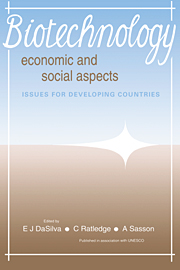Book contents
- Frontmatter
- Contents
- List of contributors
- Preface
- 1 Biotechnology: the socio-economic revolution? A synoptic view of the world status of biotechnology
- 2 Bioethanol production: economic and social considerations in failures and successes
- 3 Biofertilizers: agronomic and environmental impacts and economics
- 4 Microalgal biotechnology: is it an economic success?
- 5 Production of useful biochemicals by higher-plant cell cultures: biotechnological and economic aspects
- 6 Mushroom production – an economic measure in maintenance of food security
- 7 The economic viability of Single Cell Protein (SCP) production in the twenty-first century
- 8 The impact of biotechnology on international commodity trade
- 9 Biotechnology: socio-economic considerations, intercultural perspectives and international viewpoints
- 10 Joint microbial biotechnological ventures in developing countries: social promises and economic considerations
- 11 The economic and social implications of gene technology to developing countries
- 12 Making biotechnology appropriate – and environmentally sound
- 13 Information support for research and development in biotechnological applications
- 14 The effects of emerging biotechnologies on plant and animal agriculture – a viewpoint
- Index
6 - Mushroom production – an economic measure in maintenance of food security
Published online by Cambridge University Press: 04 August 2010
- Frontmatter
- Contents
- List of contributors
- Preface
- 1 Biotechnology: the socio-economic revolution? A synoptic view of the world status of biotechnology
- 2 Bioethanol production: economic and social considerations in failures and successes
- 3 Biofertilizers: agronomic and environmental impacts and economics
- 4 Microalgal biotechnology: is it an economic success?
- 5 Production of useful biochemicals by higher-plant cell cultures: biotechnological and economic aspects
- 6 Mushroom production – an economic measure in maintenance of food security
- 7 The economic viability of Single Cell Protein (SCP) production in the twenty-first century
- 8 The impact of biotechnology on international commodity trade
- 9 Biotechnology: socio-economic considerations, intercultural perspectives and international viewpoints
- 10 Joint microbial biotechnological ventures in developing countries: social promises and economic considerations
- 11 The economic and social implications of gene technology to developing countries
- 12 Making biotechnology appropriate – and environmentally sound
- 13 Information support for research and development in biotechnological applications
- 14 The effects of emerging biotechnologies on plant and animal agriculture – a viewpoint
- Index
Summary
Introduction
Everyone wishes to remain healthy so as to work cheerfully and enjoy life to its fullest extent. A primary source for health support comes from food. For a long period of time, many fungi have been highly valued as food to fight against hunger, as a condiment to enrich the flavour of dishes and also as supplements to help maintain good health. These properties have made fungi even more popular in recent years, and this can be witnessed by the increasing demands for higher production volumes of many edible fungi in the local and international markets.
General biology of a mushroom
Life cycles A mushroom is the fruiting organ of a filamentous fungus which in most cases is a basidiomycete bearing the sexual cells, basidia, to carry out meiosis and dispersal of spores (Fig. 6.1). This filamentous fungus has a haploid form whose cells can be multinucleate (coenocytic), e.g. Agaricus bisporus (syn. A. brunnescens) and Volvariella volvacea, or uninucleate, e.g. Lentinula edodes (syn. Lentinus edodes) and Pleurotus ostreatus. Some mushrooms are self-fertile, e.g. A. bisporus and V. volvacea, while others are self-sterile but cross-fertile, e.g. L. edodes and P. ostreatus, and only after mating, fruit bodies called mushrooms are produced (Figs 6.2–6.5). For the latter species, there is usually a characteristic dikaryotic stage featured by a hyphal form with clamp connections at septa formed after mating (Fig. 6.1).
Fruiting Aggregation of the aerial hyphae by coiling and multiple forms of hyphal fusions turns a fungus into a three-dimensional ordered fruit body primordium (Figs 6.6 and 6.7).
- Type
- Chapter
- Information
- Biotechnology: Economic and Social AspectsIssues for Developing Countries, pp. 110 - 141Publisher: Cambridge University PressPrint publication year: 1992
- 4
- Cited by

